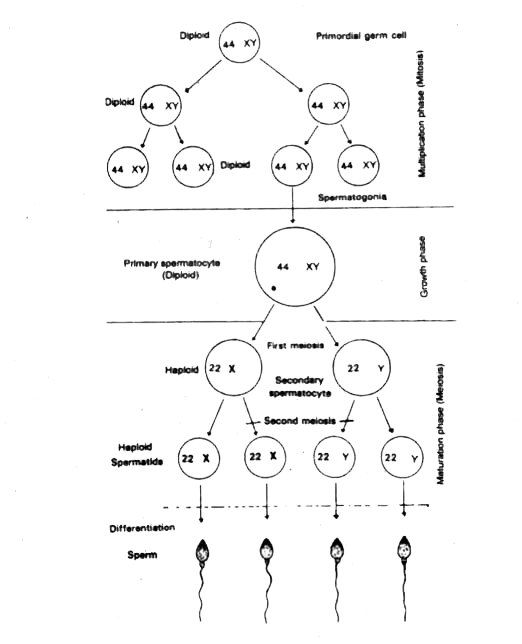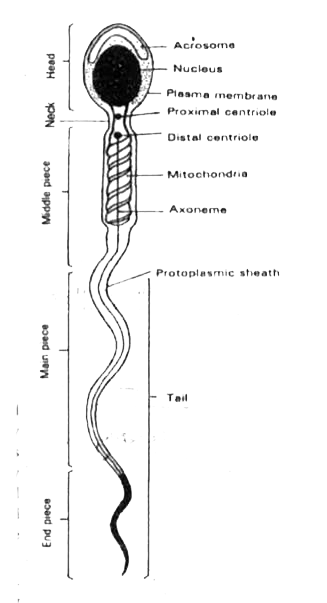What is Spermatogenesis ? Explain the process of spermatogenesisi.Solution in Kannada
SPERMATOGENESIS:Formation of haploid sperms from the diploid spermatogonial cells of the testes is called spermatogenesis. Primordial germ cells give rise to spermatogonial cells and sertoli cells. It is the spermatogonial cells that develop into the spermatozoa. Spermatogenesis involves four phases.. viz..
a. Multiplication Phase
b. Growth Phase
c. Maturation Phase
d. Spermiogenesis.
(a) Multiplication Phase: The diploid spermatogonial Distal centriole cells of the seminiferous tubules divide repeatedly by mitosis to form more spermatogonial cells.Mitochondria Among them only a few will enter into growth phase and others are kept in reserve.
(b) Growth Phase: Spermatogonial cells obtained from the multiplication phase grow in size, however they still remain diploid. These cells are now called Protoplasmic sheath primary spermatocytes.
(c) Maturation Phase: This phase involves two g successive divisions. viz., Meiosis I and Meiosis II. The meiosis I is reductional and two haploid cells are formed from each primary spermatocyte. The resultant cells of I meiotic division are called secondary spermatocytes. These secondary spermatocytes undergo meiosis II which is equational. As a result each secondary spermatocyte produces two haploid cells of equal size called spermatids. Hence, four haploid spermatids are formed during maturation phase from each diploid primary spermatocyte.
(d) Spermiogenesis: Spermatids are not gametes.They are ordinary haploid cells. During spermiogenesis or spermateliosis each spermatid in association with sertoli cells become tadpole like, flagellated and highly motile gamete called spermatozoan or sperm.


Topper's Solved these Questions
- HUMAN REPRODUCTIONBOOK - SUBHASH PUBLICATIONCHAPTER - HUMAN REPRODUCTIONEXERCISE - THREE MARKS QUESTIONS AND ANSWERS
1 Videos
- HUMAN HEALTH AND DISEASEBOOK - SUBHASH PUBLICATIONCHAPTER - HUMAN HEALTH AND DISEASEEXERCISE - FIVE MARKS QUESTION
10 Videos
- MICROBES IN HUMAN WELFAREBOOK - SUBHASH PUBLICATIONCHAPTER - MICROBES IN HUMAN WELFAREEXERCISE - FIVE MARK QUESTIONS
4 Videos
Similar Questions
Draw a labelled diagram of a section through ovary.
View SolutionWhat are the various routes by which transmission of human immunodeficiency virus takes place ?
View SolutionWhat are biofertilisers? Write the main sources of biofertilisers and explain their functions.
View Solution(a) Explain the process of spermatogenesis in humans.
View SolutionWhat is spermatogenesis? Briefly describe the process of spermatogenesis.
View Solutionशुक्राणुजनन क्या है ? संक्षेप में शुक्राणुजनन की प्रक्रिया का वर्णन करे ।
View Solutionशुक्राणुजनन क्या है ? संक्षेप में शुक्राणुजनन की प्रक्रिया का वर्णन कीजिए |
View SolutionWhat is spermatogenesis? Briefly describe the process of spermatogenesis.
View SolutionWhat is spermatogenesis? Explain the process of spermatogenesis.
View SolutionWhat is Spermatogenesis ? Explain the process of spermatogenesisi.
View SolutionWhat is spermatogenesis? Briefly describe the process of spermatogenesis.
View SolutionWhat is spermatogenesis? Briefly describe the process of spermatogenesis.
View SolutionExplain the process of spermatogenesis with diagram.
View SolutionWhat is spermatogenesis? Briefly describe the process of spermatogenesis.
View SolutionDefine spermatogenesis. Explain the process of spermatogenesis.
View SolutionWhat is spermatogenesis? Briefly describe the process of spermatogenesis.
View Solution
